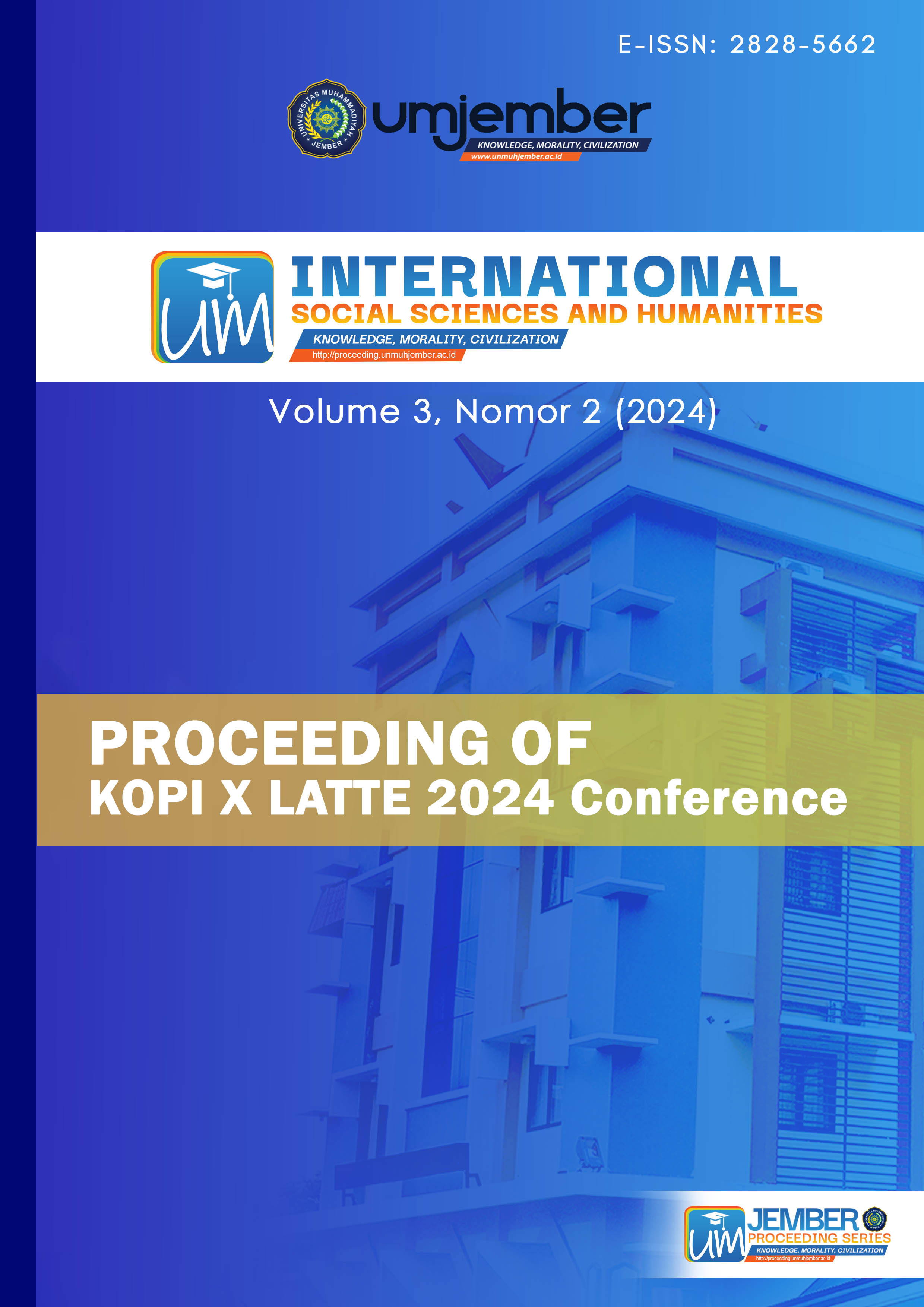The Use of The Traditional Game of Hopscotch for The Early Reading Abilities of Children Aged 5 – 6 Years
DOI:
https://doi.org/10.32528/issh.v3i2.588Keywords:
Traditional games, Hopscotch, Early reading abilitiesAbstract
The traditional game of hopscotch has become a part of early childhood play experiences in various regions. This game is typically played individually by children, hopping through each hopscotch square using one foot. A child who successfully completes all the hopscotch squares by hopping on one foot is the winner of the game. In today's era, the traditional game of hopscotch has become an alternative medium used to stimulate aspects of development in children aged 5 - 6 years, particularly in the beginning stages of reading ability. The objective of this research is to determine the effectiveness of the traditional game of hopscotch on the early reading abilities of children aged 5 - 6 years. The research method used is a literature review, gathering various information from relevant studies regarding hopscotch and the early stages of reading in children aged 5 - 6 years. The results of this literature review indicate the effectiveness of using the traditional game of hopscotch to enhance the early reading abilities of children aged 5 - 6 years. Through hopscotch, children are able to become familiar with letters or phonemes (the sounds of letters), both vowels and consonants. Then, the children read words as a cohesive whole unit, with their attention shifting more towards the pictures in their surrounding environment, and the children are able to comprehend the meaning of a word.
Downloads
References
Altani, A., Protopapas, A., Katopodi, K., & Georgiou, G. K. (2020). From individual word recognition to word list and text reading fluency. Journal of Educational Psychology, 112(1), 22–39. https://doi.org/10.1037/edu0000359
Chandra, C., Rahman, R., Damaianti, V. S., & Syaodih, E. (2021). Krisis Kemampuan Membaca Lancar Anak Indonesia Masa Pandemi COVID-19. Jurnal Basicedu, 5(2), 903–910. https://doi.org/10.31004/basicedu.v5i2.848
Cooper, B. R., Moore, J. E., Cleveland, M., & Greenberg, M. T. (2014). Patterns of early reading and social skills associated with academic success in elementary school. Early Education and Development, 25(8), 1248–1264. https://doi.org/10.1080/10409289.2014.932236
Darmawati, N. B., & Widyasari, C. (2022). Permainan Tradisional Engklek dalam Meningkatkan Motorik Kasar Anak Usia Dini. Jurnal Obsesi : Jurnal Pendidikan Anak Usia Dini, 6(6), 6827–6836. https://doi.org/10.31004/obsesi.v6i6.3487
Dewi, E. R., Nurasiah, I., & Nurmeta, I. K. (2023). Media Engklek Untuk Meningkatkan Keterampilan Membaca Permulaan Siswa Kelas 1 Sekolah Dasar. Jurnal Educatio FKIP UNMA, 9(3), 1409–1415. https://doi.org/10.31949/educatio.v9i3.5742
Gustira, A., Nurani, Y., & Wulan, S. (2023). Permainan Tradisional Petualangan Gobak Sodor dan Kemampuan Pemecahan Masalah. Jurnal Obsesi : Jurnal Pendidikan Anak Usia Dini, 7(1), 1173–1185. https://doi.org/10.31004/obsesi.v7i1.4071
Hapidin, H., Utami, I. O., & Wulan, S. (2023). Efektivitas Penggunaan Media Permainan Engklek Maritim untuk Meningkatkan Kesadaran Lingkungan Maritim Anak Usia Dini. Jurnal Obsesi : Jurnal Pendidikan Anak Usia Dini, 7(2), 2400–2412. https://doi.org/10.31004/obsesi.v7i2.4183
Hapidin, & Yenina. (2016). Pengembangan Model Permainan Tradisional Dalam Membangun Karakter Anak Usia Dini. JPUD - Jurnal Pendidikan Usia Dini, 10(2), 201–212. https://doi.org/10.21009/jpud.102.01
Hewi, L., & Shaleh, M. (2020). Refleksi Hasil PISA (The Programme For International Student Assesment): Upaya Perbaikan Bertumpu Pada Pendidikan Anak Usia Dini). Jurnal Golden Age, 4(01), 30–41. https://doi.org/10.29408/jga.v4i01.2018
Jeti, L. J., & Manan, M. (2022). Coastal parents Perceptions of the Implementation of Early Childhood Education in Buton Islands. Jurnal Obsesi : Jurnal Pendidikan Anak Usia Dini, 6(4), 2656–2664. https://doi.org/10.31004/obsesi.v6i4.2240
Kartika, W. I., & Putri, A. A. P. (2023). Analisis Kemampuan Membaca Permulaan di Taman Kanak-Kanak. Jurnal Obsesi : Jurnal Pendidikan Anak Usia Dini, 7(4), 4097–4106. https://doi.org/10.31004/obsesi.v7i4.4372
Mailani, O., Nuraeni, I., Syakila, S. A., & Lazuardi, J. (2022). Bahasa Sebagai Alat Komunikasi Dalam Kehidupan Manusia. Kampret Journal, 1(1), 1–10. https://doi.org/10.35335/kampret.v1i1.8
Mariani, D., & Rizawati. (2021). Peningkatan Kemampuan Membaca pada AUD melalui Media Kartu Bergambar. Jurnal Pendidikan Tambusai, 5(3), 6112–6119.
Mubarok, Y., Sudana, D., & Nurhuda, Z. (2023). Penggunaan Media Gambar dalam Meningkatkan Kemampuan Membaca Anak Usia 6-7 Tahun. Jurnal Obsesi : Jurnal Pendidikan Anak Usia Dini, 7(6), 6843–6854. https://doi.org/10.31004/obsesi.v7i6.5555
Munawaroh, H. (2017). Pengembangan Model Pembelajaran dengan Permainan Tradisional Engklek Sebagai Sarana Stimulasi Perkembangan Anak Usia Dini. Jurnal Obsesi : Jurnal Pendidikan Anak Usia Dini, 1(2), 86. https://doi.org/10.31004/obsesi.v1i2.19
Nabila, R., Utami, D. T., Alucyana, A., Yunita, Y., Ramadani, P., Rizka, N., & Novitasari, Y. (2023). Rotating Alfabet untuk Meningkatkan Kemampuan Membaca Permulaan Anak Usia Dini. Jurnal Obsesi : Jurnal Pendidikan Anak Usia Dini, 7(5), 6453–6462. https://doi.org/10.31004/obsesi.v7i5.5454
Nurjaman, I., & Yuniwanti, R. (2022). Upaya Meningkatkan Kemampuan Mengenal Huruf Melalui Media Permainan Engklek Modifikasi Pada Anak Kelompok B Di Paud Mutiara Kasih Tangerang. Ceria: Jurnal Program Studi Pendidikan Anak Usia Dini, 11(1), 1. https://doi.org/10.31000/ceria.v11i1.6634
Patiung, D. (2016). Membaca Sebagai Sumber Pengembangan Intelektual. Al Daulah : Jurnal Hukum Pidana Dan Ketatanegaraan, 5(2), 352–376. https://doi.org/10.24252/ad.v5i2.4854
Ritonga, F. R., & Fathiyah, K. N. (2023). Kemampuan Membaca Permulaan melalui Penggunaan Media Big Book untuk Anak Usia Dini. Jurnal Obsesi : Jurnal Pendidikan Anak Usia Dini, 7(5), 5907–5918. https://doi.org/10.31004/obsesi.v7i5.4560
Rohayati, R., & Budiarti, E. (2022). Menumbuhkan Literasi Membaca Awal Melalui Permainan Tradisional Engklek Di TK Nurul Aulia Depok. Aksara: Jurnal Ilmu Pendidikan Nonformal, 8(3), 1715. https://doi.org/10.37905/aksara.8.3.1715-1724.2022
Seefeldt, C., & Wasik, B. (2006). Early Education: Three-, Four-, and Five-year-olds Go to School. New Jersey: Pearson/Merrill/Prentice Hall.
Suharti, Hapidin, & Supena, A. (2018). The Importance of Pre-Reading Ability in Early Childhood: Between Theory and Reality. International Journal of Advances in Scientific Research and Engineering, 4(8), 41–45. https://doi.org/10.31695/ijasre.2018.32826
Sukma, E., Indrawati, T., & Suriani, A. (2020). Penggunaan Media Literasi Kelas Awal di Sekolah Dasar. Jurnal Inovasi Pendidikan Dan Pembelajaran Sekolah Dasar, 3(2), 103. https://doi.org/10.24036/jippsd.v3i2.107623
Wahyuni, V. S. (2021). Several Methods to Teach Reading to Early Childhood. International Journal of Ethno-Sciences and Education Research, 1(2), 36–39. https://doi.org/10.46336/ijeer.v1i2.124
Downloads
Published
Issue
Section
License

This work is licensed under a Creative Commons Attribution-NonCommercial 4.0 International License.


